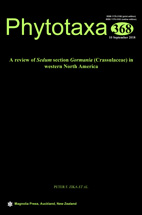Abstract
Sedum section Gormania was restricted to Oregon, Nevada and California in the western United States. After extensive field work from 2011 to 2016, we revised 17 members of the group using floral and vegetative characters, resulting in the acceptance of four new taxa in California. A serpentine endemic from the mountains of western Tehama County was recognized as S. rubiginosum. It was separated from S. kiersteadiae by its dense rosettes, overlapping stem leaves and non-apiculate corolla. A serpentine endemic from low elevation canyons in Del Norte County was described as S. patens. It was distinguished from S. laxum by its white spreading petals and yellow anthers. A plant of high elevation, serpentine and non-serpentine sites in Siskiyou County was circumscribed as S. marmorense; it differed from S. oregonense in its sepals and inflorescence with a thick granular waxy deposit, and leaves in dense rosettes. Sedum paradisum was segregated from S. obtusatum, raised to species level, and divided into two subspecies. Plants of the northern Sierra Nevada were newly defined as S. paradisum subsp. subroseum, separable with nodding young flowering shoots and a disjunct range in Butte, Plumas and Sierra counties. Sedum flavidum and Sedum eastwoodiae were removed from S. laxum sensu stricto, and raised to species rank, based on floral characters. We clarified the concept of S. obtusatum subsp. retusum, and restored it to the rank of species as S. sanhedrinum; it was restricted to Glenn, Lake, Mendocino, and Tehama counties, California. Sedum flavidum and S. oregonense as defined here showed more morphological variation than previously understood. Finally, we remarked on hybridization and cleistogamy observed in the field.

